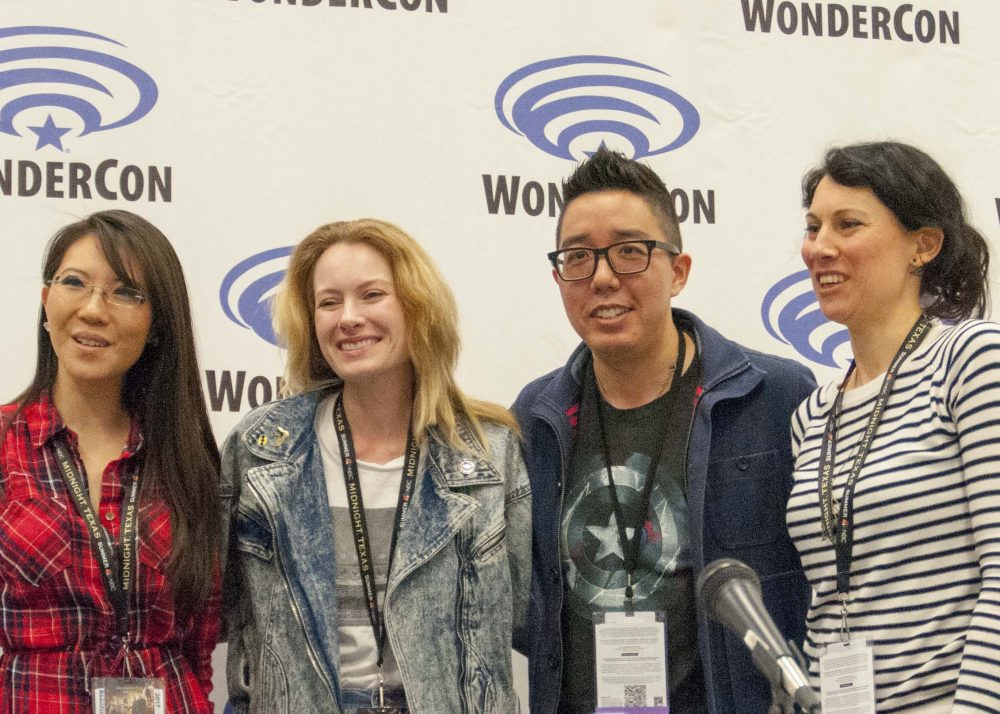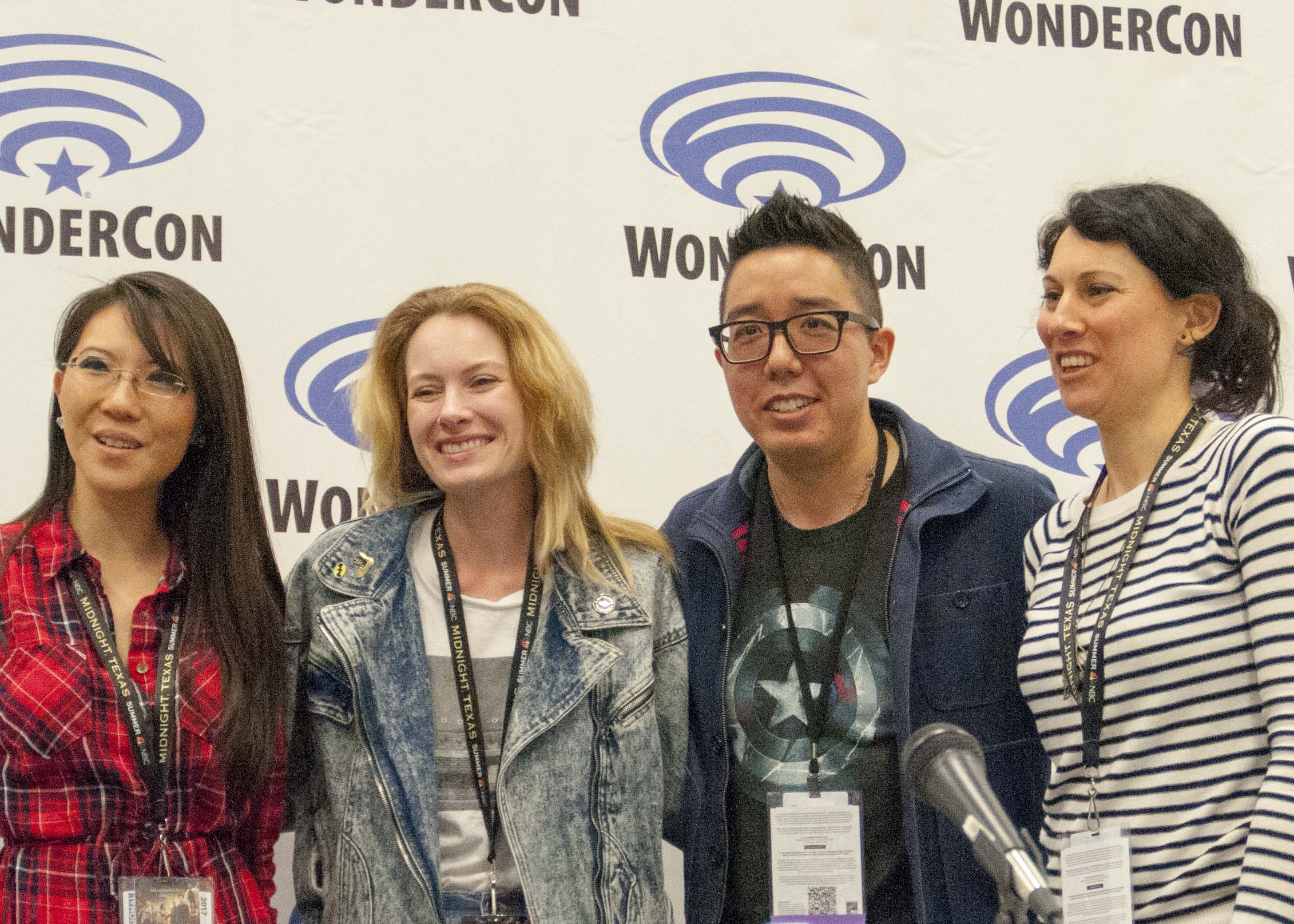
Many an artist of the comic, graphic novel, and manga format will cringe when the respective writer they work with asks for the dreaded “action scene.” Perhaps more confusing than the rendering of hands, the action scene can easily confound any veteran artist; Do I go for a side-profile view, or over the shoulder? Is this running scene supposed to be blurry, sharp, or just vague lines of direction? How the heck do I make this choking scene look believable? To discuss this, moderator Jessica Tseang (comic book historian and founder of Little Geek Girl) gathered industry artists Hope Larson, Andy Park, and Marguerite Sauvage.
Tseang started the ball rolling by asking, “Has your style changed over the years?”
Hope Larson who has produced the webcomic series I Was There and Just Returned, worked on a graphic novel adaption of A Wrinkle in Time, and has her own publishing imprint called Tulip Tree Press, was first to answer. “Oh yes. I’ve been [drawing] action for about five to six years now… And now, I am working on Batgirl,” she said.
Andy Park, Korean comic book and concept artist who’s worked on the Tomb Raider comic and on the Visual Development team for Marvel Studios, also agreed that his art has greatly changed. “I don’t think there isn’t anyone who’s style doesn’t change over time.”
Marguerite Sauvage also chimed in, having the unique position of being an illustrator who later found herself getting into comics. “I’ve been in the comic book industry for three years now,” she said. “As I use to be an illustrator, it was a big change to do full page narrations… [For comics], you have to think of the story you want to tell with the action.”
The depiction of action through writing or art almost come from two different mindsets. On this subject, Larson said it was “about the emotion” that the art can illicit. Park said it was like the “concept art versus creature design” in which he has to deal with during visual development. “For Sony Pictures and Marvel I have to do ‘key frames,’ which mark the beginning and end of an action sequence. My comic book past really helped me a lot with this… like [when I worked] on Tomb Raider.”
Especially for aspiring artists, the thought of “color or black-and-white” will eventually arise. “Sometimes it’s good to do everything in grayscale to get some texture,” said Sauvage. “To me, color just seems like a luxury.”
“I think it works both way,” chimed in Park. “These are tools after all… they can add or detract.”
Perhaps one of the most prevalent questions a veteran artist will be asked is, “What advice can you give to find one’s style?” To this, Sauvage said, “By digesting influences. When I was young, I copied everything that I liked… It’s a long process to find that balance. As if to clarify this, Andy Park added, “Jim Lee was my number-one artist. I wanted to be like him. I’d copy in the beginning [of my art] and study. I really emulated more than copied… I never wanted to be [Jim Lee’s] clone, and didn’t really concern myself with finding my style. I just drew. It should come naturally. Just trust that it will come.”
“You’ll have your own quirks that you’ll lean into,” said Larson still on the subject. “That’s part of your style, so make sure you incorporate them.” And like the others, she added, “It’ll come naturally.”
Getting back to the idea of depicting action, the three artists shared some tips to keep in mind. The most common and basic words of advice they had were to study action, know anatomy, watch videos on fighting like MMA, expand the panel to two or more if what you’re trying to convey is too involved, and to of course read comics or watch animation. “There’s a thing called the ‘One-hundred and eighty degree’ rule,” instructed Andy Park. “What it says is to not switch back between one point of view to the other. If you have to do it, maybe have a transition panel to break it up.”
The idea of conveying quickness is another action detail that varies from artist to artist. Should it be uniform across the board? “It depends on the scene,” said Hope Larson. “Having a preference is why writers work with specific artists,” responded Park. To this, Larson added, “That’s why I like working with a writer who’ve I worked with many times before. It’s not that I don’t like working for other writers, but with those I’ve worked a lot with, I know what they want.”
Lastly, the three artists discussed the validity of changing one’s style purposefully to fit a particular writer or market. “I feel they hire me because of my style,” said Marguerite Sauvage. “If I change, I feel like they would say, ‘What have you done!?’”
Andy Park said, “In my job as a concept designer for film, we are encouraged not to have a style… I feel like I have to take [it] out if I find it creeping in.”
To share the negative side of changing one’s style, Hope Larson had this to say; “I’ve been working for so long that I feel like I get approached for my style. I’m actually working on a book right now where I want to change my style, but when my publisher saw it, they told me I can’t. That if I didn’t do it in my usual style, no one would know it was me.”
More or less digressing into a panel surrounding one’s style than depicting action, the three artists still had valuable advice that any beginning or struggling artist should take to heart.







